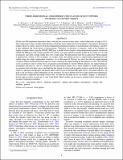THREE-DIMENSIONAL ATMOSPHERIC CIRCULATION OF HOT JUPITERS ON HIGHLY ECCENTRIC ORBITS
Author(s)
Kataria, T.; Showman, A. P.; Lewis, Nikole; Fortney, Jonathan J.; Marley, Mark S.; Freedman, Richard S.; ... Show more Show less
DownloadKataria-2013-THREE-DIMENSIONAL AT.pdf (9.636Mb)
PUBLISHER_POLICY
Publisher Policy
Article is made available in accordance with the publisher's policy and may be subject to US copyright law. Please refer to the publisher's site for terms of use.
Terms of use
Metadata
Show full item recordAbstract
Of the over 800 exoplanets detected to date, over half are on non-circular orbits, with eccentricities as high as 0.93. Such orbits lead to time-variable stellar heating, which has major implications for the planet's atmospheric dynamical regime. However, little is known about the fundamental dynamical regime of such planetary atmospheres, and how it may influence the observations of these planets. Therefore, we present a systematic study of hot Jupiters on highly eccentric orbits using the SPARC/MITgcm, a model which couples a three-dimensional general circulation model (the MITgcm) with a plane-parallel, two-stream, non-gray radiative transfer model. In our study, we vary the eccentricity and orbit-average stellar flux over a wide range. We demonstrate that the eccentric hot Jupiter regime is qualitatively similar to that of planets on circular orbits; the planets possess a superrotating equatorial jet and exhibit large day-night temperature variations. As in Showman & Polvani, we show that the day-night heating variations induce momentum fluxes equatorward to maintain the superrotating jet throughout its orbit. We find that as the eccentricity and/or stellar flux is increased (corresponding to shorter orbital periods), the superrotating jet strengthens and narrows, due to a smaller Rossby deformation radius. For a select number of model integrations, we generate full-orbit light curves and find that the timing of transit and secondary eclipse viewed from Earth with respect to periapse and apoapse can greatly affect what we see in infrared (IR) light curves; the peak in IR flux can lead or lag secondary eclipse depending on the geometry. For those planets that have large temperature differences from dayside to nightside and rapid rotation rates, we find that the light curves can exhibit "ringing" as the planet's hottest region rotates in and out of view from Earth. These results can be used to explain future observations of eccentric transiting exoplanets.
Date issued
2013-04Department
Massachusetts Institute of Technology. Department of Earth, Atmospheric, and Planetary SciencesJournal
Astrophysical Journal
Publisher
Institute of Physics/American Astronomical Society
Citation
Kataria, T., A. P. Showman, N. K. Lewis, J. J. Fortney, M. S. Marley, and R. S. Freedman. “THREE-DIMENSIONAL ATMOSPHERIC CIRCULATION OF HOT JUPITERS ON HIGHLY ECCENTRIC ORBITS.” The Astrophysical Journal 767, no. 1 (March 26, 2013): 76. © 2013 American Astronomical Society.
Version: Final published version
ISSN
0004-637X
1538-4357